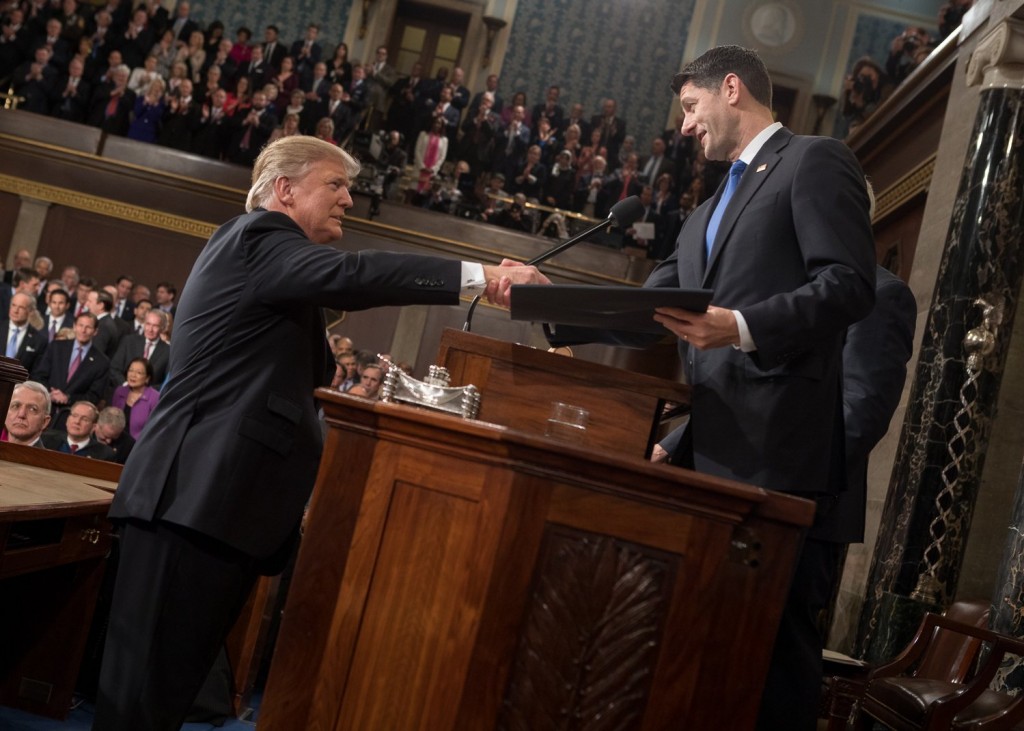
President Trump shakes hands with Speaker of the House Paul Ryan (via Wikimedia Commons)
With the House of Representatives approving a new Omnibus Appropriations bill this week which could fund the Federal government until the end of Fiscal Year 2017, and a Senate vote due soon, EZGovOpps has put together some analysis on the procurement impact of the spending plan as well as budget comparisons. The budgets we will compare, in particular, are the spending plans President Trump unveiled for FY18 (covered by EZGovOpps here and here), and the similar proposal from the President for funding the rest of FY17, which would include $18 billion in cuts to Federal agencies.
The POTUS proposal for the end-of-year budget included cuts similar to the budget blueprint that the administration released for FY18. In line with a 28% cut, or a combined $10.1 billion reduction for the State Department and U.S. Agency for International Development (USAID), the Trump administration sought a $1.5 billion cut for the State Department and $1.1 billion cut to the USAID budget for the rest of the fiscal year. This would have a major impact on the agencies that provided a combined $35 billion in contract and grant awards in 2016, and had already awarded a total $14.8 billion in contract and grant awards this year, according to USASpending. Under the new Omnibus Appropriations bill, the State Department will instead receive a reduction of $683 million from the Obama-requested FY17 budget numbers, but allots $6.1 billion for Embassy facility and security upgrades overseas. USAID will receive a much smaller reduction of $63 million, still $82 million above 2016 spending levels.
Rather than cut the year’s National Institutes of Health (NIH) funding by $1.2 billion, per the POTUS proposal, the Omnibus Appropriations bill actually increases NIH funding by $2 billion, for a total of $34 billion. In 2016 alone, NIH awarded $28 billion of its $32 billion budget in contracting and grant dollars. However, the extra $2 billion will be somewhat limited in scope to “increases for research related to Alzheimer’s disease, the brain, antibiotic resistance, and the Precision Medicine Initiative.”
Another major target for the Trump administration, the Federal Emergency Management Agency (FEMA) under the Department of Homeland Security (DHS), will survive spending cuts unscathed, and will actually experience increases in grant funding above even Obama-requested funding for a $2.7 billion total.
In other sections of DHS, the Presidents largest procurement mission has been delayed by the new spending bill. DHS will receive a $1.1 billion increase in funding, less than the $3 billion requested by the administration. Immigration and Customs Enforcement (ICE) will receive an extra $380 million for detention bed procurement, part of a $3.7 billion push for “39,324 detention beds, electronic monitoring, and GPS tracking alternatives to detention,” and Customs and Border Protection (CBP) will receive a total $11.4 billion including $772 million for “improvements to and maintenance of existing infrastructure, technology investments, and increased Border Patrol agent hiring” requested by President Trump in March.
Importantly, the extra $1.9 billion which President Trump requested but the Appropriations bill does not include, was a “down payment” for beginning the construction of the border wall planned for the US-Mexico Border. The wall, which has been estimated to cost as much as $21.6 billion, has already seen two Requests for Proposal (RFPs) released by CBP (they can be seen here and here). The proposal phase is ongoing. CBP stated that they received a number of proposals in the “low hundreds,” though it is not clear if that includes some proposals that were less serious than others. These proposals were due on April 4th, and CBP will name the companies moving on to Phase II of the process by May 8th. The RFPs make it clear that funding has already been allotted for these opportunities, as they are only for wall prototypes. Further funding for wall construction will have to wait at least the FY18 budget negotiations begin.
Interested in learning more about the Federal agencies mentioned above, or tracking specific procurement opportunities like the border wall? Sign up for a free trial with EZGovOpps. As the premiere market intelligence platform, EZGovOpps can provide the information needed to follow procurement trends, produce personalized opportunity forecasts, and provide custom analyst-updates for a complete understanding of the Federal contracting market today.
Don’t forget to view our full GovCon News section for more intel.
Published May 4, 2017


